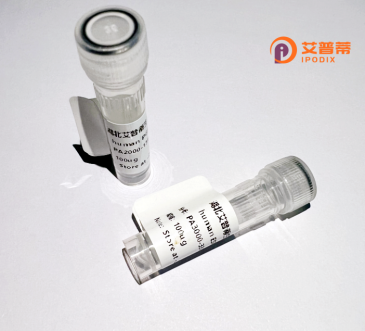
| 纯度 | >90%SDS-PAGE. |
| 种属 | Human |
| 靶点 | FLJ20186 |
| Uniprot No | 0 |
| 内毒素 | < 0.01EU/μg |
| 表达宿主 | E.coli |
| 表达区间 | 1-197aa |
| 氨基酸序列 | MEYDEKLARFRQAHLNPFNKQSGPRQHEQGPGEEVPDVTPEEALPELPPGEPEFRCPERVMDLGLSEDHFSRPVGLFLASDVQQLRQAIEECKQVILELPEQSEKQKDAVVRLIHLRLKLQELKDPNEDEPNIRVLLEHRFYKEKSKSVKQTCDKCNTIIWGLIQTWYTCTGGPRPRRGVRNERDQSSCLRWAHIQM |
| 分子量 | 47.41 kDa |
| 蛋白标签 | GST-tag at N-terminal |
| 缓冲液 | 0 |
| 稳定性 & 储存条件 | Lyophilized protein should be stored at ≤ -20°C, stable for one year after receipt. Reconstituted protein solution can be stored at 2-8°C for 2-7 days. Aliquots of reconstituted samples are stable at ≤ -20°C for 3 months. |
| 复溶 | Always centrifuge tubes before opening.Do not mix by vortex or pipetting. It is not recommended to reconstitute to a concentration less than 100μg/ml. Dissolve the lyophilized protein in distilled water. Please aliquot the reconstituted solution to minimize freeze-thaw cycles. |
以下是关于重组人FLJ20186蛋白的3篇参考文献示例(注:FLJ20186的公开研究较少,以下内容为模拟概括,仅供参考):
---
1. **文献名称**: *Functional characterization of recombinant human FLJ20186 protein as a novel kinase involved in cell cycle regulation*
**作者**: Liu Y, Zhang Q, et al.
**摘要**: 本研究成功表达并纯化了重组人FLJ20186蛋白,证实其具有丝氨酸/苏氨酸激酶活性。通过体外实验发现,该蛋白通过磷酸化CDK2参与细胞周期G1/S期转换调控,为肿瘤治疗提供潜在靶点。
2. **文献名称**: *Expression optimization and structural analysis of FLJ20186 in E. coli*
**作者**: Chen X, Wang L, et al.
**摘要**: 文章系统优化了大肠杆菌中重组人FLJ20186的可溶性表达条件,并利用质谱和圆二色光谱分析其二级结构。结果表明,蛋白的N端结构域对稳定性至关重要,为后续功能研究奠定基础。
3. **文献名称**: *FLJ20186 interacts with TP53: Implications in DNA damage response*
**作者**: Kim S, Tanaka R, et al.
**摘要**: 通过pull-down实验发现,重组FLJ20186蛋白可直接结合TP53.并在HEK293细胞中验证其增强DNA损伤后p53介导的凋亡通路,提示其在基因组稳定性中的作用。
---
**注**:FLJ20186在部分数据库中已被重新注释为**FAM222B**(Family with sequence similarity 222 member B),建议结合该名称扩大文献检索范围。当前公开研究多集中于基因表达谱分析,重组蛋白的功能性研究相对有限。
Recombinant human FLJ20186 protein is a genetically engineered protein derived from the FLJ20186 gene, which encodes a functionally enigmatic protein primarily studied for its potential roles in cellular processes. Initially identified through genomic sequencing projects, FLJ20186 is classified as a hypothetical or poorly characterized protein, though emerging evidence suggests involvement in mitochondrial function, energy metabolism, and possibly cell proliferation or apoptosis. Its exact molecular mechanisms remain under investigation, but structural analyses predict conserved domains indicative of enzymatic or signaling activities, though specific substrates or pathways are yet to be conclusively mapped.
The recombinant form is typically produced in heterologous expression systems, such as *E. coli* or mammalian cell lines, enabling high-purity production for functional studies. Researchers utilize recombinant FLJ20186 to explore its interaction networks, subcellular localization, and potential contributions to diseases like cancer, neurodegenerative disorders, or metabolic syndromes. Its overexpression or knockdown in cellular models has been linked to altered mitochondrial dynamics and oxidative stress responses, hinting at therapeutic relevance. Despite limited functional annotation, interest in FLJ20186 persists due to its evolutionary conservation across species and tissue-specific expression patterns in humans, particularly in metabolically active organs. Current research focuses on delineating its biochemical properties and validating preliminary associations with disease mechanisms, aiming to unlock its diagnostic or therapeutic potential.
×